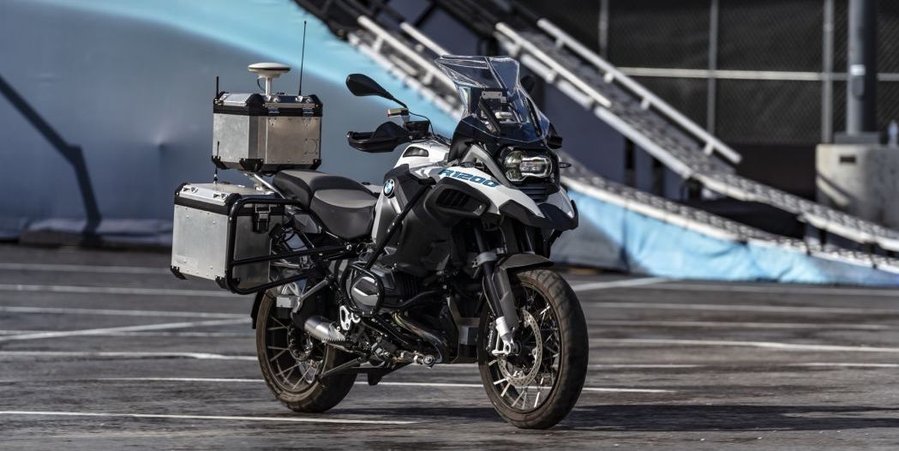BMW makes a self-riding motorcycle. We ask, ‘Why?’

At CES this week, BMW provided demonstrations of its self-riding motorcycle. First unveiled back in September, the motorcycle can start, slow down, turn, and stop by itself. All of this is accomplished via a suite of proprietary software housed in some hard pack cases mounted on the back of the bike — an otherwise stock-looking R 1200 GS, save for the inclusion of a tall radio antenna on the rear.
The antenna is used as a receiver for the human-operated controller, who, from a distance, commands things like when the bike should start or stop, as well as providing loose directional steering inputs (e.g. wide right turn, tight left turn) that the bike then interprets through its software and road-reading capabilities. The project was apparently the result of a top-secret, five-year endeavor by BMW Motorrad, the point of which is, on first glance, mysterious at best.
"There is no consumer plan for this bike. This is not going to replace your pizza delivery scooter," says Peyton. "Rather, we are asking how we can aid the rider and help them to be safer and enjoy the ride more," says Michael Peyton, vice president of the Americas for BMW Motorrad. "Initially, interestingly enough, there was not a lot of pushback. I guess this is the benefit of being part of a carmaker aware of where technology is going. The big decisions were around deciding what further tech we want to involve, because part of charge at BMW is to be progressive and innovative."
Unlike the recent two-wheeled concept from Honda, BMW's riderless motorcycle does not use gyroscopic/"Rick & Morty" portal technology in order to keep itself balanced. Instead the focus was on creating and testing technologies that can help train a new rider with advice about how quickly (or not quickly) to enter a corner, or to support a rider who is not paying the closest attention to the road — an even more perilous decision on a motorcycle than in a car, where one is typically surrounded by nearly two-tons of impact absorbing metal, plastic and foam, instead of a minimal amount of the earth's atmosphere and the ire and blindness of every other vehicle on the road.
"We primarily use steering to keep the bike upright after takeoff," says Peyton. "If you were to stop it without the side stops down, it would fall over. This was done essentially to mimic the kind of inputs that a rider would use to keep the bike upright."
We are somewhat used to the driver in a car being obscured by tinted windows, diminutive stature or just a lack of attention on our part, so a car that drives itself, while still unsettling, does not terrorize on first glimpse. This is far less true for a motorcycle. Watching one operate on its own at speed, as we did at CES, is like seeing a giraffe pull itself upright on two legs, run down a field dribbling a basketball, and shoot a perfect three-pointer. It gets to the heart of what is eerie and uncanny about intelligent machines: they shake our foundational belief in our own necessity. (If giraffes could play basketball, they would destroy the NBA.)
It also seems to answer a question that no one is asking. Sales of luxury motorcycles like Ducatis have been strong in recent years because well-heeled customers are looking for a sense of engagement, adventure and physical viscerality that is often limited — in part by the very driver assistance systems now included in this motorcycle — in contemporary cars. So, while a self-riding motorcycle is an interesting achievement from a scientific perspective, it begs the rather pervasive question: Why?
"One of the big reasons we did this is because when you start thinking about the coming of autonomous cars and the internet of things evolving, we want to make sure that motorcycles are a part of this ongoing conversation," says Peyton. "We also want to look at ways to mitigate the possibility, as autonomy comes in, of roads being shut to non-autonomous-enabled vehicles, especially to motorcycles, because they're too much of an unpredictable variable." To this end, BMW Motorrad is involved in further conversations on the subject with industry and governmental regulators. "We want to make sure that we, that motorcycles, are involved in the conversation as standards develop, so we can help answer questions like, 'How does an autonomous vehicle interact with a motorcycle that's lane splitting.'"
There is one other reason why the company decided to green-light this project. "When people see it," Peyton says, "they say, 'Hey, that's really cool.'"
Nouvelles connexes


